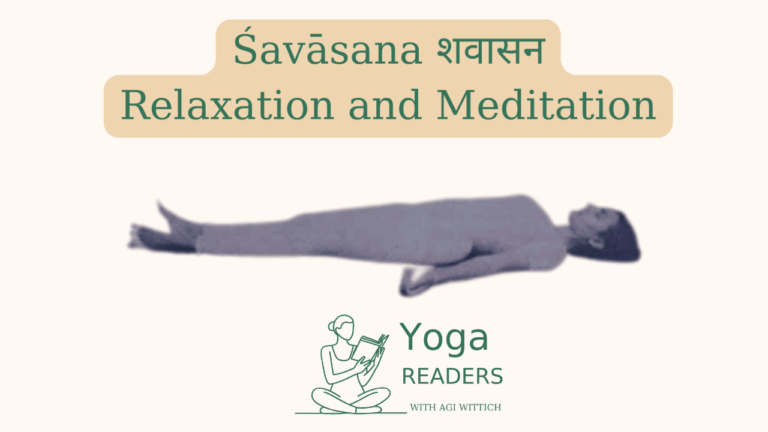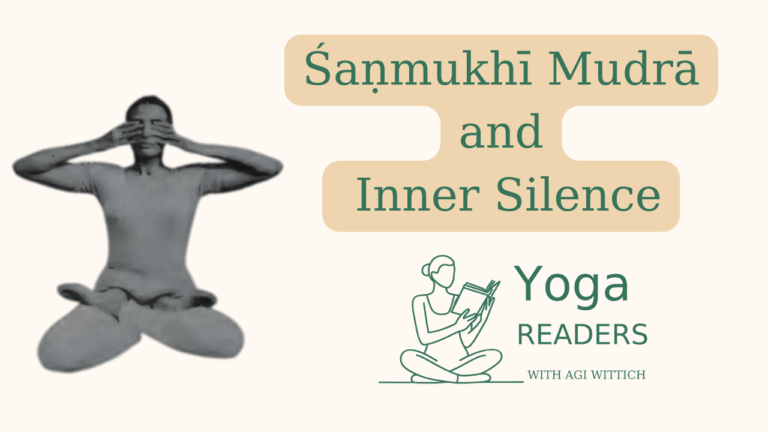
Śavāsana: The Art of Conscious Relaxation
In the vast repertoire of yoga āsanas, Śavāsana (Corpse Pose) holds a
Unit 8 includes XIII On the Threshold of Peace, XIV Hints and Suggestions for the Practice of Pranayama, XV Pranayama Techniques and Effects, XVI Dhyana (meditation)
This unit bridges physical practice with subtle spiritual development through three key components: mudrās, prāṇāyāma, and meditation. Beginning with Mahā Mudrā and Ṣaṇmukhi Mudrā, Geeta explains their role in developing internal awareness and control. Her treatment of Śavāsana is particularly detailed, presenting it as “most difficult to master” with meticulous instructions for every aspect, from physical alignment to subtle breath awareness.
The prāṇāyāma section opens with traditional wisdom comparing breath control to the gradual taming of wild animals, emphasizing proper preparation through 4-6 months of āsana practice. She details six primary breathing practices, from fundamental awareness to complex techniques like Nāḍī Śodhana, each presented with precise instructions addressing physical positioning, breath mechanics, and common challenges.
The meditation chapter (Dhyāna) concludes by presenting meditation as the culmination of yogic practice, using the metaphor of the body as a vehicle (vāhana) to explain how proper physical preparation supports meditative states. Geeta provides sophisticated understanding of brain function in meditation, distinguishing between the “active brain” and the “meditative brain,” while offering practical guidance for developing stable practice.
How does Geeta explain the relationship between physical positioning and deeper states of awareness?
What is the significance of the metaphor comparing breath control to taming wild animals? How does this inform our approach to pranayama?
How does Geeta describe the progression from gross to subtle awareness in these practices?
How does Geeta distinguish between different qualities of peace in meditation?
After five transformative months traversing the landscape of Geeta Iyengar’s revolutionary text “Yoga: A Gem for Women,” our global community of over 1,700 practitioners gathered for our concluding session. What began in April as an exploration of foundational practices culminated in August with an intimate examination of yoga’s innermost dimensions—those subtle practices that bridge the gap between physical asana and the profound depths of spiritual realization.
The Challenge of Shavasana: More Than Meets the Eye
Our session opened with a deceptively simple question: What aspect of Shavasana do you find most challenging? The responses revealed the profound complexity hidden within what appears to be yoga’s most basic posture.
Community members shared deeply personal reflections. One practitioner described the difficulty of entering Shavasana without a teacher’s guidance, noting how the mind “tosses and turns” when left to its own devices during solo practice. Another spoke of how Shavasana became nearly impossible during pregnancy and in the aftermath of October 7th, when lying still invited an overwhelming flood of emotions and anxious thoughts.
These honest admissions illuminated a crucial teaching from Geeta’s text: Shavasana, despite appearing effortless from the outside, is “the most difficult posture to master.” This paradox—that complete stillness requires tremendous skill—reveals the sophisticated understanding that underlies traditional yoga practice.
Death as Teacher: The Profound Symbolism of Shavasana
Geeta’s description of Shavasana as “an experience of death in a living state” initially struck some as morbid, but deeper exploration revealed its transformative wisdom. As Dr. Wittich explained during our session, this practice requires courage to temporarily release our grip on the will to live—not from depression or despair, but from a place of strength and stability.
This teaching carries particular relevance in our current global climate of uncertainty and loss. The practice of conscious letting go in Shavasana becomes a rehearsal for life’s inevitable transitions, offering us tools for navigating change with grace and equanimity.
Geeta’s precise instructions for Shavasana—from shoulder blade placement to facial tissue relaxation—demonstrate that this apparent simplicity conceals sophisticated biomechanical and energetic principles. The recommended adaptations, including a blanket under the chest for respiratory conditions and an eye covering for mental agitation, show how traditional practices can be modified for individual needs without losing their essential potency.
The Three Mudras: Sealing Energy for Inner Journey
Our exploration of mudra practices—Maha Mudra, Shanmukhi Mudra, and the preparatory techniques for Shavasana—introduced concepts that many Western practitioners encounter rarely in typical yoga classes. These “seals” redirect energy inward, teaching pratyahara (sensory withdrawal) in tangible, accessible ways.
The community discussion revealed varying levels of familiarity with these practices. While some had never encountered mudras in their yoga training, others had learned them as essential preparation for pranayama. This disparity highlights the evolution and adaptation of yoga as it travels across cultures and contexts.
Geeta’s attention to how these practices specifically benefit women—addressing issues from uterine displacement to emotional stability—demonstrates her revolutionary approach to adapting ancient techniques for contemporary women’s health and wellbeing.
Pranayama: The Science of Breath Regulation
The extensive guidelines Geeta provides for pranayama practice reveal the sophisticated methodology underlying what might appear to be simple breathing exercises. Her emphasis on quality over quantity, the importance of maintaining rhythm and sound consistency, and the careful attention to individual capacity reflect a mature understanding of how breath practices affect the nervous system.
The recommendation to practice asanas for four to six months before beginning pranayama sparked discussion among participants about whether modern yoga teaching has perhaps moved too quickly toward advanced practices. This timing consideration reflects the traditional understanding that the body must be prepared to handle the powerful effects of conscious breath regulation.
Throughout our exploration, Geeta’s specific guidance for women practitioners stood out as both revolutionary and practical. Her detailed recommendations for adapting pranayama during menstruation, pregnancy, postpartum recovery, and menopause demonstrate a sophisticated understanding of how yoga practice can support women through all life phases.
The suggestion that certain pranayama practices can “check the menstrual flow” while simultaneously relieving fatigue offers hope for women seeking natural approaches to menstrual management. Similarly, her guidance for adolescent girls—recommending specific breathing practices while cautioning against others before age twenty—shows remarkable attention to developmental considerations often overlooked in contemporary yoga instruction.
Meditation: Beyond the Body, Through the Body
Geeta’s approach to meditation instruction challenges common misconceptions about spiritual practice requiring transcendence of physical reality. Instead, she emphasizes the body as our essential vehicle for realization, requiring careful maintenance and attention rather than abandonment.
Her practical framework for beginning meditation practice—five to ten minutes daily, preferably in the early morning, practiced before pranayama—offers accessible entry points while maintaining connection to traditional methodology. The emphasis on consistent timing and the recognition that “meditation defies description” yet requires systematic preparation reflects the mature understanding of a seasoned practitioner and teacher.
The discussion portion of our session, while not recorded to protect participant privacy, generated rich exchanges about personal experiences with these subtle practices. The vulnerability shared by community members—from struggles with post-traumatic stress affecting Shavasana practice to questions about adapting teachings for contemporary life—demonstrated the living application of ancient wisdom.
These conversations revealed how Geeta’s teachings continue to resonate across decades and cultures, offering practical tools for navigating modern challenges while maintaining connection to yoga’s transformative potential.
As we completed our five-month journey through “Yoga: A Gem for Women,” the session carried both achievement and melancholy. Dr. Wittich’s mixed emotions—pride in our collective accomplishment alongside sadness at concluding study of such a beloved text—reflected the community’s investment in this shared exploration.
The Continuing Journey
While our formal study of “Yoga: A Gem for Women” has concluded, the real work now begins. The mudras, Shavasana techniques, pranayama guidelines, and meditation frameworks Geeta shared require patient, consistent application to reveal their full transformative potential.
The upcoming community gathering will provide space for processing our collective journey and charting our next literary adventure. Whether we revisit “Light on Life” for our expanded community or explore new territory, the foundation we’ve built through studying Geeta’s profound work will continue to support our individual and collective growth.
The invitation remains open for all seekers interested in approaching yoga as more than physical exercise—as a comprehensive path for navigating the complexities of contemporary life while maintaining connection to wisdom traditions that have supported human flourishing for millennia.
As Geeta reminds us in her conclusion, meditation “can be experienced anytime, anywhere,” but it requires the humble beginning that systematic study and practice provide. Our five-month journey through her teachings has offered such a beginning, preparing ground for the supreme joy that awaits those willing to undertake the patient work of genuine spiritual development.

In the vast repertoire of yoga āsanas, Śavāsana (Corpse Pose) holds a

In the rich tradition of yoga, Śaṇmukhī Mudrā stands as a profound
“Writing, Practice, and the Evolution of Iyengar Yoga for Women” This session…
What a joy it was to connect with so many of you…
Reading Unit 1 includes the Forwards, Preface, I First Steps in Yoga,…
Reading Unit 2 includes IV Are Women Eligible for Yoga?, V The…
A Special Session with N. Sine Ozsoy This talk will provide a…
Reading Unit 3 includes VIII Know Your Body, IX Yoga Sadhana, X…
Reading Unit 4 includes I: Standing asana, II: Forward Bends Chapter Summary…
A special exploration for the Yoga Readers community Join a unique session…
Reading Unit 5 includes III Sitting and Supine Asana, IV Inverted Asanas,…
Reading Unit 6 includes VI Asanas: Twists, VII Asanas: Backbends, VIII Asanas:…
Reading Unit 7 includes IX Pregnancy Asanas and Pranayama & X Advanced…
Unit 8 includes XIII On the Threshold of Peace, XIV Hints and…